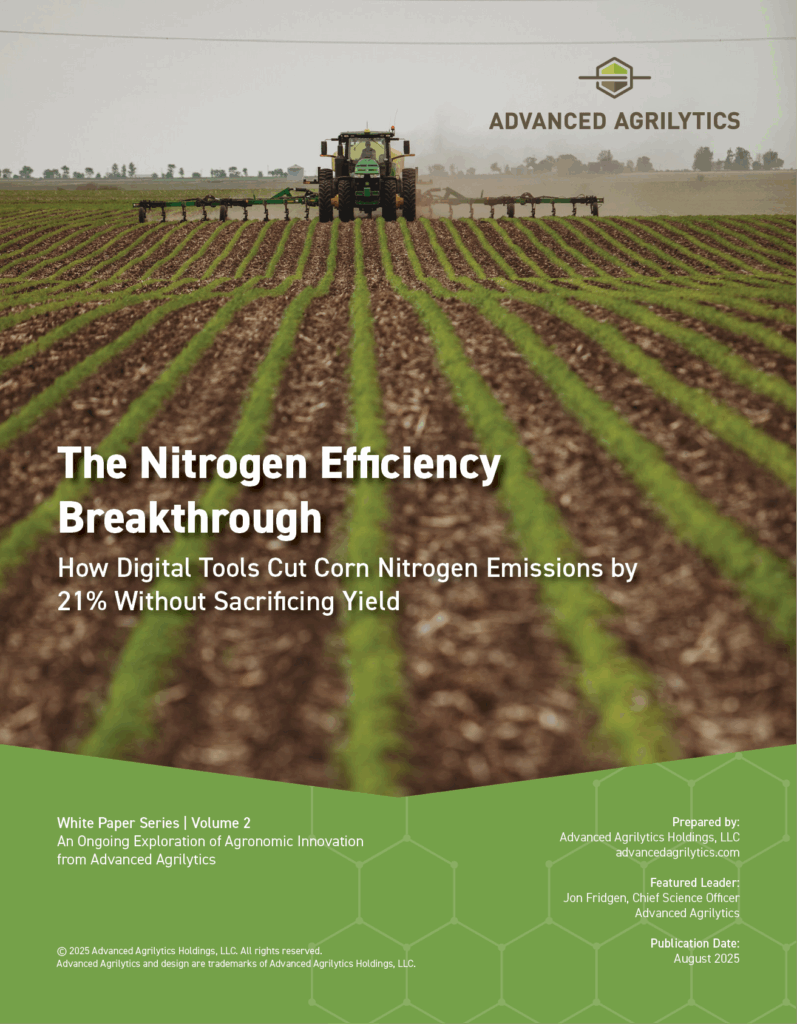In our first blog, we explored how predictive agronomy helps growers make smarter nitrogen decisions and improve efficiency across every acre. In this post, we take that discussion further by examining the real economic advantages of better nitrogen use efficiency (NUE) and how small improvements in efficiency can make a big difference in profitability.

Explore the Research Behind the Economic Impact
The data in this article comes from The Nitrogen Efficiency Breakthrough white paper, which details how small improvements in efficiency can protect more than $80 per acre in revenue.
Get the complete study to see how prediction turns nitrogen efficiency into measurable profit.
Why Nitrogen Efficiency Matters to the Bottom Line
Every grower knows that nitrogen is one of the biggest expenses in corn production. But what many do not see is how small inefficiencies can quietly drain profit, even in good yield years.
Rising fertilizer costs, unpredictable weather, and tightening margins have made it more important than ever to ensure every pound of nitrogen is doing its job. Overapplication, poorly timed applications, or nitrogen loss in saturated areas all add up to lost efficiency and lost revenue.
That is where nitrogen use efficiency (NUE) becomes more than a metric. It becomes a measure of financial performance.
What the Data Shows: Efficiency Protects Profit
In The Nitrogen Efficiency Breakthrough white paper, we analyzed NUE across more than 750,000 acres of cornfields managed by Advanced Agrilytics from 2022 to 2024. By pairing our predictive agronomy methodology with in-field performance data, we were able to quantify how changes in efficiency impact profitability.
Across all acres studied, a 0.15-pound increase in nitrogen applied per bushel (reflecting reduced efficiency) resulted in an average loss of $80.42 per acre in gross revenue. That loss comes from both higher input costs and yield drag associated with inefficient nitrogen use.
When scaled across the dataset, the potential annual revenue loss reached nearly $60 million.
| NUE Change | Additional N Cost / Acre | Gross Revenue Delta / Acre |
| +0.05 | $3.76 | ($23.69) |
| +0.10 | $6.58 | ($51.80) |
| +0.15 | $8.96 | ($80.42) |
| +0.20 | $11.00 | ($108.52) |
| +0.25 | $12.82 | ($135.82) |
Breaking Down the Financial Impact
For growers, this relationship is straightforward. As nitrogen use efficiency (NUE) worsens, nitrogen costs rise and yield performance falls.
Each 0.05 increase in NUE value (meaning more nitrogen is needed per bushel) leads to:
- $3.76 to $12.82 more spent per acre on nitrogen
- $23.69 to $135.82 less gross revenue per acre, depending on the level of inefficiency
While those numbers may seem small, they add up fast. Across 1,000 acres, even a moderate decline in efficiency could mean a $80,000 to $100,000 swing in annual profitability.

This chart illustrates the relationship between declining NUE and its effect on N application rate (gray bars) and corn yield (green bars). Each 0.05 increase in the NUE score results in higher N inputs and greater yield loss.
Why Prediction Makes Efficiency Achievable
Improving NUE is not about applying less nitrogen. It is about applying it smarter.
Our predictive agronomy approach uses real-world spatial data to identify where nitrogen is likely to be lost and how much each acre truly needs. By modeling nitrogen behavior within soil and weather environments, we can help growers place and time applications for maximum return.
That means:
- Less waste in high-loss zones.
- More stable yields across variable acres.
- Greater input efficiency without sacrificing performance.
Predictive nitrogen management moves growers beyond reaction and toward proactive planning, helping every pound of nitrogen deliver measurable ROI.
Efficiency as a Business Strategy
At Advanced Agrilytics, we see nitrogen efficiency as more than a sustainability goal. It is a business strategy that strengthens the bottom line while reducing risk.
The data is clear. Improving nitrogen efficiency by even a small margin can protect revenue, reduce unnecessary costs, and build long-term resilience in production. Predictive agronomy is what makes that improvement possible by turning precision into profitability.
Key Takeaway
Better nitrogen efficiency does not require a dramatic change in inputs. It requires better insight into how, where, and when nitrogen performs best.
By pairing agronomic science with predictive analytics, growers can achieve higher efficiency, lower costs, and stronger ROI at the same time.
Ready to See What Predictive Agronomy Could Do for Your Operation?
Talk with one of our agronomy experts about how predictive nitrogen management can help improve your efficiency and profitability.